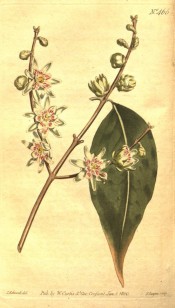Chimonanthus praecox Link.
Fully hardy, vigorous, broadly upright, deciduous shrub with lance-shaped leaves arranged in opposite pairs and pendant, fragrant, sulphur-yellow flowers, 2.5cm across and marked brown or purple inside, borne on the bare stems in winter. To 4m. [RHSE, SD, HM, Don].
Horticultural & Botanical History
‘The learned and instructive Kaempfer in his Amaen. Exot. that vast fund of most useful information, gives a figure of this plant, in which it is represented both with flowers and seed vessels, accompanied with a description and short account of it; from which we learn that it is cultivated in Japan as an ornamental plant, that the flowers are produced in February, before the leaves, that they have the scent of the violet, but become unpleasant on being long smelt to. Hearing that Lord Coventry was the first who possessed this plant in England, I took the liberty of writing to his Lordship in January 1799, to request some information on this point, as well as some others relative to its culture, &tc. On the 13th of the same month, his Lordship had the goodness to send me a beautiful specimen of the plant in bloom, a seedling plant one year old, together with a seed-vessel of the year 1798, and some seeds; in the Earl’s letter is the following passage:-“the beauty of the Calycanthus praecox at this moment surpasses all description, it is covered with blossoms from top to bottom, and the fragrance of it may be perceived at the distance of fifty yards from the conservatory.” [BM t.466/1800].
‘It was introduced in 1766, and was first cultivated in perfection by the late earl of Coventry, in whose conservatory at Croome, we believe, the original plant is still growing. […] If the plant is sheltered from the weather, or should the winter prove mild, it continues flowering from October to April: the blossoms have a delicious fragrance.’ [LBC no.617/1822].
‘The prettiest shrub we have at this time is Chimonanthus fragrans. It is planted at the foot of a south west wall, it has never been trained or pruned, but is allowed to take its own course; it is ten feet in height, fifteen feet in width, and ten feet through. There are thousands of blooms now expanding on it, and if the weather continues mild, thousands more will open; every part from top to bottom is loaded with its lovely blooms, whose delicious perfume is sensibly felt a long distance off.’ Geo. Archer, Gardener, Finedon Hall. [Gard. Chron. 1858]. The variety grandiflora is figured in the Botanical Register. [BR f.451/1820].
History at Camden Park
Listed in all published catalogues [T.309/1843].
Notes
Published Mar 02, 2009 - 04:58 PM | Last updated Feb 28, 2010 - 10:54 AM
| Family | Calycanthaceae |
|---|---|
| Category | |
| Region of origin | China |
| Synonyms |
|
| Common Name | Wintersweet |
| Name in the Camden Park Record | Chimonanthus fragrans |
| Confidence level | high |


